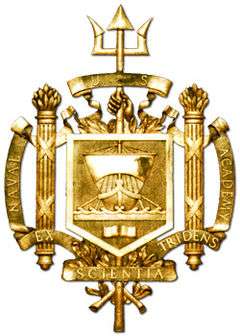Albert S. Barker
Albert Smith Barker (March 31, 1845 – January 30, 1916) was an admiral in the United States Navy who served during the American Civil War and the Spanish–American War.
Albert Smith Barker | |
|---|---|
 Albert Smith Barker in 1900 | |
| Born | March 31, 1845 Hanson, Massachusetts |
| Died | January 30, 1916 (aged 70) Washington, D.C. |
| Place of burial | |
| Allegiance | |
| Service/ | |
| Years of service | 1859–1905 |
| Rank | Rear Admiral |
| Commands held | USS Newark C-in-C, North Atlantic Fleet USS Pennsylvania (ACR-4) USS Enterprise (1874) Oregon (BB-3) Commandant New York Navy Yard |
| Battles/wars | American Civil War Spanish–American War |
Biography
Born in Hanson, Massachusetts, Barker graduated from the Naval Academy in 1862. He served aboard the Mississippi, Monongahela and Niagara during the Civil War.
In July 1883, Albert Barker was commander of the screw-sloop USS Enterprise while on the East Coast of Africa at Zanzibar. He wrote a report on the "Trade of Zanzibar" of imports and exports for the years 1882–83. The trade of the port principally being with the United States, England, Germany, and France. Many vessels from these countries were employed in this trade process with America, such as the British man-of-war HMS London stationed at Zanzibar as a store ship.
During the Spanish–American War he commanded the battleship USS Oregon and participated in the bombardment of Santiago on July 1, 1898. He was Commander-in-Chief of the North Atlantic Fleet from 1903 to 1905.
Rear Admiral Barker died January 30, 1916, in Washington, D.C.[2]
Namesake
The destroyer USS Barker (DD-213) was named for him.
Gallery
 Barker as a Lieutenant, 1864
Barker as a Lieutenant, 1864- Barker as Rear Admiral, no later than 1902
Dates of rank

| Ensign | Lieutenant | Lieutenant Commander | Commander | Captain |
|---|---|---|---|---|
| O-1 | O-3 | O-4 | O-5 | O-6 |
 |
 |
 |
 |
 |
| 1862 | February 22, 1864 | July 25, 1866 | March 28, 1877 | May 5, 1892 |
| Commodore | Rear Admiral |
|---|---|
| O-7 | O-8 |
 |
 |
| 1899 | October 10, 1905 |
Barker never held the rank of LTJG (O-2) due to it not being created until later years. As well, Commodore is the modern day equivalent to Rear Admiral (lower half) and Rear Admiral then is equivalent to today's Rear Admiral (Upper Half).
Notes
- "Albert Smith Barker, Rear Admiral, United States Navy". arlingtoncemetery.net. Retrieved August 1, 2010.
- "Rear Admiral Barker Dies". Brooklyn Eagle. January 31, 1916. p. 16. Retrieved January 30, 2020 – via Newspapers.com.
References
- Marquis Who's Who, Inc. Who Was Who in American History, the Military. Chicago: Marquis Who's Who, 1975. ISBN 0837932017 OCLC 657162692
- Reports from the Consul of the United States on the Commerce, Manufactures, Etc. of their consular districts. No. 31-July 1883. Published by the department of state, according to act of congress.
Attribution
- This article incorporates text from the public domain Dictionary of American Naval Fighting Ships. The entry can be found here.
| Military offices | ||
|---|---|---|
| Preceded by Francis J. Higginson |
Commander-in-Chief, North Atlantic Fleet July 1903 – March 1905 |
Succeeded by Robley D. Evans |